Numerous Karelian Finns engage in commemoration practices, which help them maintain their identity and pass on their traditions to younger generations. One of these practices is the relatively new tradition of performative reenactments of the original evacuation journey from ceded Karelia in the aftermath of the Second World War. Initiated in 2006 by the Society of Children Displaced by the War (Finnish, Evakkolapset), this annual ritual of remembrance has evolved into a highly effective vehicle of collective identification.
This paper argues that the Karelian Evacuee Trail, rather than being a manifestation of ludic identity fragmentation attributed to the postmodern age, in fact performs a socially grounding function. Through numerous articulations with personal memories of the participants, as well as with the most ethically salient aspects of the ethno-national narrative, the Evacuee trail carries a strong moral message and intervenes in the present by promoting allegiance to the Karelian and Finnish ethno-national communities.
Introduction
Although the idea that the most intimate understanding of the past comes from performing it, rather than from grasping it cognitively, is not new, it gained a new lease of life during the last decades of the twentieth century. Numerous critics have reflected upon the growing popularity of historical reenactment and performance history more broadly. Reenactment covers a variety of media and genres, from living history museums and medieval pageants performed by amateur enthusiasts, to television, virtual and augmented reality installations and history-themed video games. No longer do we consider it sufficient to “understand” the past or “learn” about it; we increasingly choose to “experience” it and “identify” with it, both sympathetically and empathetically.1
Commemoration practices have helped members of the Finno-Karelian evacuee community to maintain their identity and pass on their traditions to younger generations. This paper deals with the relatively new tradition of performative reenactment of the original evacuation journey from ceded Karelia during and after World War II. The Karelian Evacuee Trail (Finnish, Evakkovaellus), was launched in 2006 by the Society of Children Displaced by the War (Finnish, Evakkolapset). It has since been held each year during the summer months in different parts of Finland: Lohja (2007), Virolahti (2006, 2009, 2014), Urjala (2010), Mikkeli (2011), Somero (2012), Kangasala (2013) and Porkkala (2015).
The fieldwork conducted for this project included my participation in two Evacuee Trails (2012 and 2013), archival research and media analysis. During fieldwork, I audio-recorded interviews with relevant stakeholders. Most interviews were conducted in the English language. I am grateful to my husband Toivo Talikka for his help with materials in the Finnish language.
About the Karelian Evacuee Trail
The Evacuee Trail is a relatively recent phenomenon. During the latter half of the twentieth century, mass commemorations of the evacuation were not encouraged. According to Kirsi Niukko, remembering Karelia was part of a particular “counterculture” in post-war Finland. “Since direct expressions of yearning were regarded as forbidden among the Karelian migrants,” Niukko explains, “nostalgia was given a language, songs, symbols, and embellished rhetoric”.2 Since the collapse of Cold-War geopolitics, the status of Karelianism has changed dramatically. As author Anne Kuorsalo believes, the former “closet Karelianism” no longer exists: now everyone claims to be at least “a quarter Karelian” and thus have some connection to the experience of displacement.3
Kuorsalo has described the Trail as an “emotional voyage”, with the scope of “empathising with what it was like to undertake the evacuation journey once the home territory was ceded to the Soviet Union”.4 Participants have compared the emotions they experienced during the trail to those they had as “homeland tourists” visiting their old homes across the border. The theme of self-discovery is particularly prominent here, and it is this theme more than anything else that sets the Evacuee Trail apart from various forms of hobbyist reenactment.
The scenario of the trail is simple: a long walk through the Finnish countryside (Figure 1), with speeches, singing, dancing, kantele music (Figure 2) and dramatic performances of the evacuee experience. The affective intensity of these performances relies on their implied assumption that between the participants’ personal, ethnic and national levels of identification there is a near-perfect overlap. Ultimately, the effect of the entire event is a certain “therapeutic centring” of the “endangered” Karelian identity, as a salutary corrective to the Finnish identity more broadly.

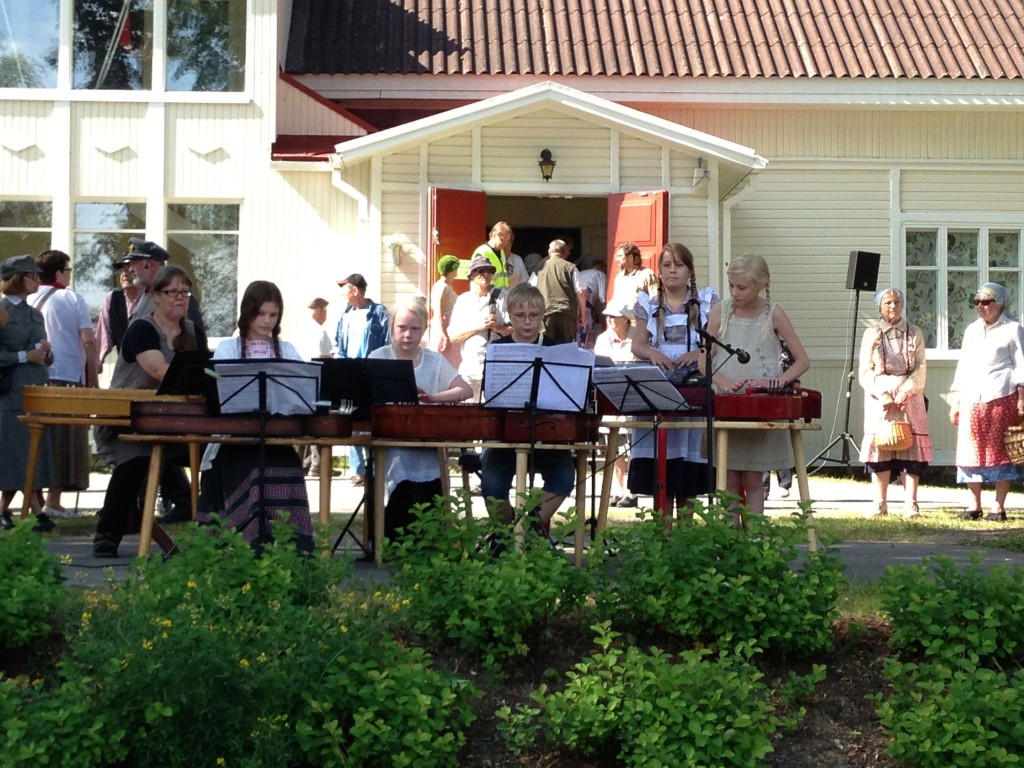
Stories of evacuation and resettlement
Ethnic and national identification often rely on certain narratives of shared origin or common destiny. Rather than being simply given, these narratives function as myths, and are continually re-negotiated, both contextually — in relation to social circumstances — and intertextually, within a web of texts that circulate in a given society. Myths deal with exceptional people performing remarkable deeds, and serve to provide moral guidance for an entire imagined community.5 They are “stories drawn from a society’s history”, which have the “power of symbolizing that society’s ideology and of dramatizing its moral consciousness”.6 According to memory studies scholar Yael Zerubavel, it is the turning points in history that are the most liable to be transformed into myths. Endowed with powerful symbolism, says Zerubavel, historical transitions occupy a “liminal location between periods” and present a “pattern of separation and reincorporation typical of rites of passage in general”.7 Calamitous events have a particular bonding power: suffice it to mention slavery for the African diaspora or the “great famine” for the Irish.
World War II represents such a cataclysmic turning point in recent Finnish history. It is therefore not surprising that stories of the evacuation and resettlement have become a staple element of Finnish culture, and a template for a master narrative of Karelianity, and of the Finnish national discourse more broadly. The departure represents a liminal point, in which the evacuees had to suspend the safety of the daily life routine and face the unknown. The very moment of leaving thus signifies loss of “ontological security”, or the confidence that “most human beings have in the continuity of their self-identity and in the constancy of the surrounding social and material environments of action”.8
During the post-war period, stories of evacuation were shared at family gatherings and published by evacuee organisations as single-authored memoirs and edited collections. They have by now become a key element of the collective memory of the evacuee population, and a “sub-genre” of the Finnish national discourse. These narratives are extremely rich, charged with meanings that informed the self-perception of the Karelian evacuee community. For example, one of my respondents recalls:
My mother told me many times that it was very difficult, they only had a few hours to pack everything they could take with them. And it was very, very difficult to move with the cows and with some things and items that they could bring with them. It was easier for my father because he was in military service at the time and he was very close to the war, but he was so young, and he never got to the fighting really.9
Stories of evacuation often include vivid imagery, which serves as a template for commemorative performance. A woman from Jaakkima thus remembers her family’s hasty departure in a horse-drawn sleigh, with a bright moon lighting their way: “The lines of evacuee sleighs and cows were continuous. We had to herd the cows constantly, because they wanted to return home”.10 Evacuee memoirs typically describe readily recognisable objects, settings and scenarios, which lend themselves to being reproduced as part of the reenactment ritual. Horse-driven carriages (Figure 3), farm animals (Figure 4), fields and forests make an easy transition from the ethno-national myth to the ritual of commemoration; so do the inherited period clothes (Figure 5) and antiquarian objects (Figure 6) from family heritage collections.11
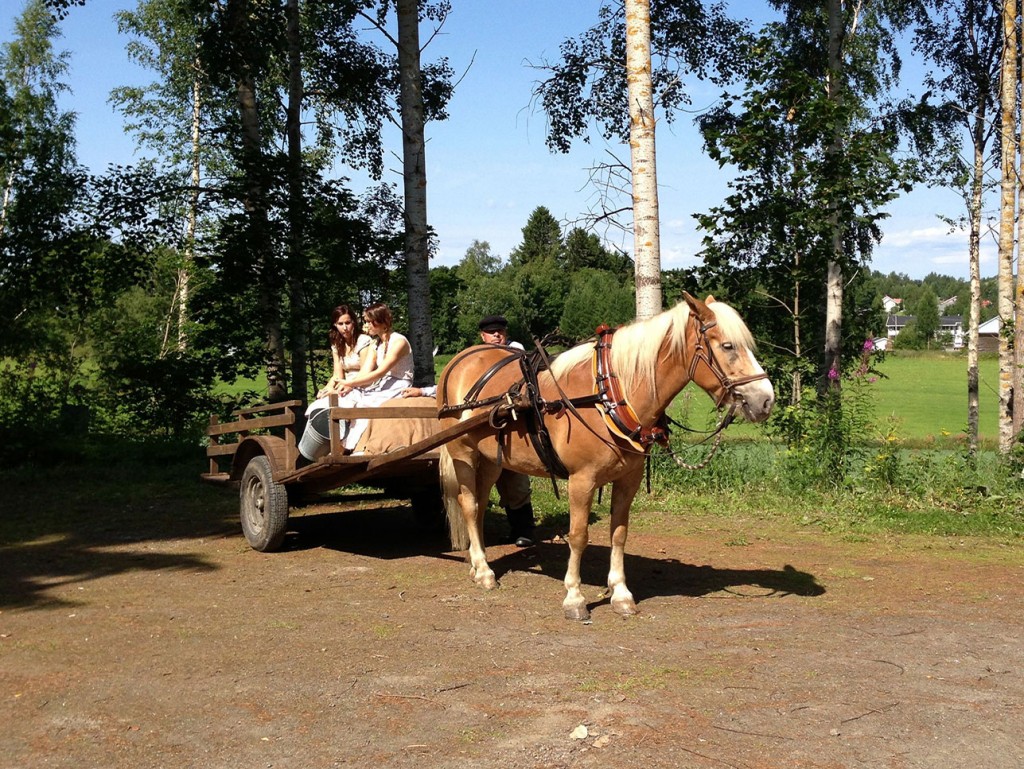
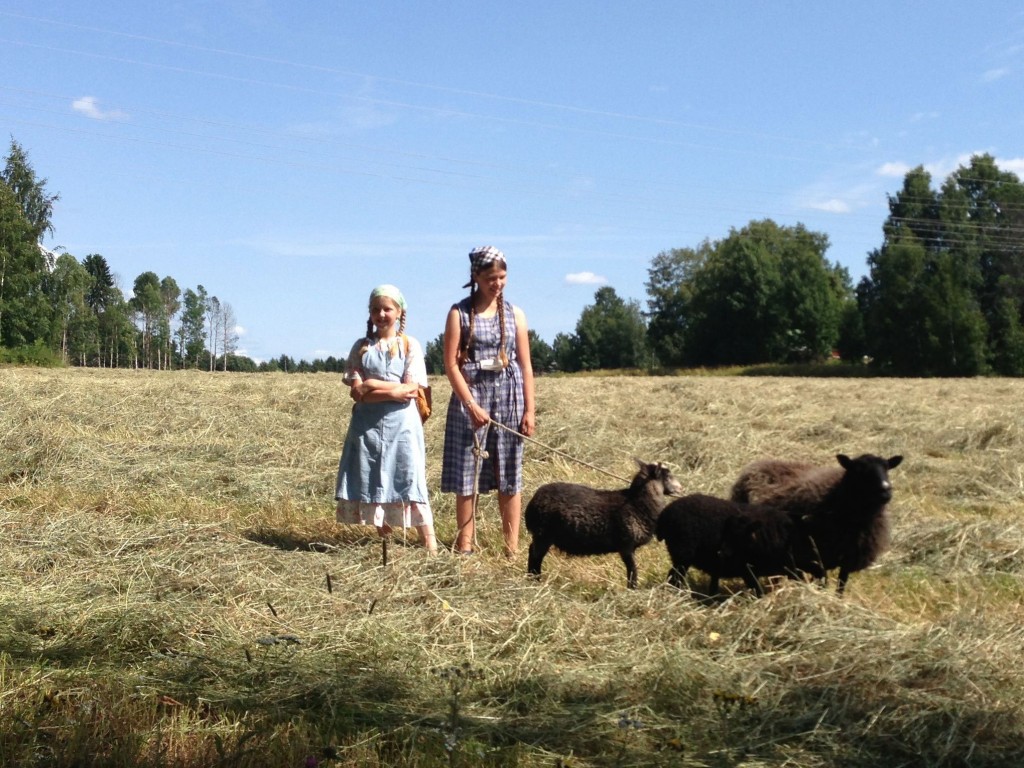

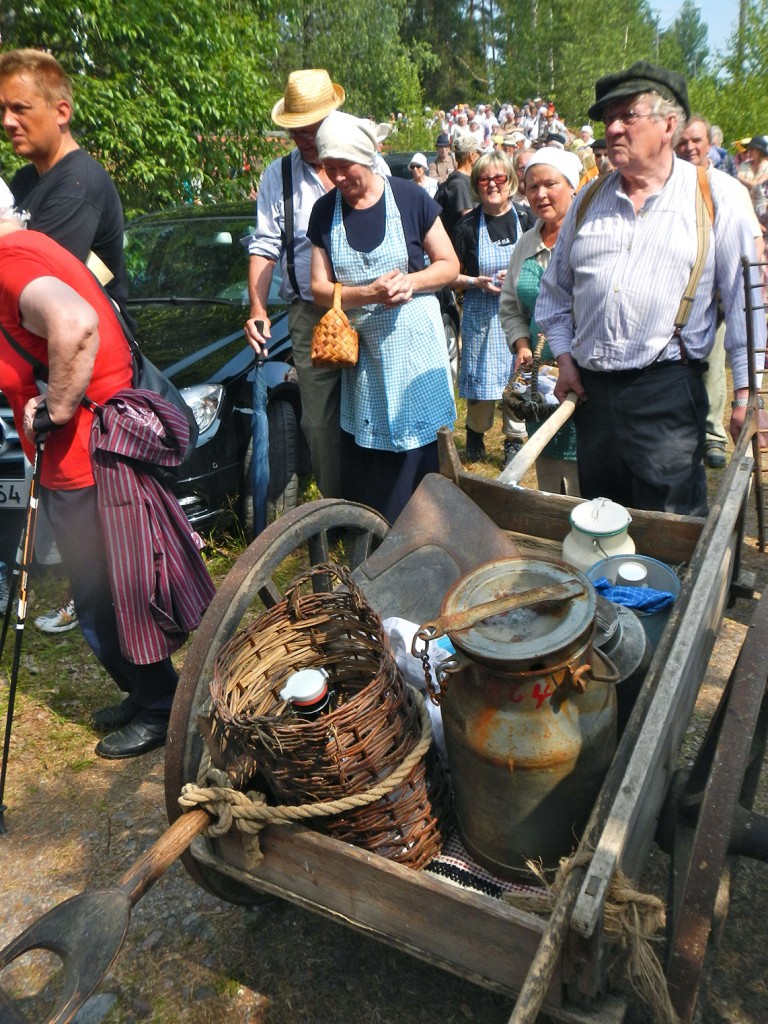
I have written elsewhere about the significance of objects for the preservation of Karelian identity and traditions:
In the lives of the Karelian evacuees and their descendants, things related to the “old homeland” are of particular importance. Whether they are still used as working utensils, or displayed as mirrors of the self and mnemonic devices, they always respond to present day and identity-driven concerns and agendas. Almost every person of Karelian descent I have spoken to has something to show: a hand-woven wall hanging, a grandfather’s clock that survived the evacuation trail, a pair of birch-bark shoes or a food container stamped during the evacuation with the number of their municipality in the ceded territory. Some of these household collections have developed into small-scale institutions with limited public access, which serve the purpose of maintaining communal bonds and preserving Karelian traditions.12
In the Evacuee Trail, individuals try to emulate their own family backgrounds as closely as possible: thus, wearing fashionable tailored clothes is taken to signify the urban roots of an individual’s family, while peasant attire points to their rural origins.13 Not all props used in the Evacuee Trail are family heirlooms: rare and collectable items, such as vintage cars and trucks (Figure 7) and authentic army uniforms (Figure 8) are typically on loan from museums and hobbyist reenactment groups.
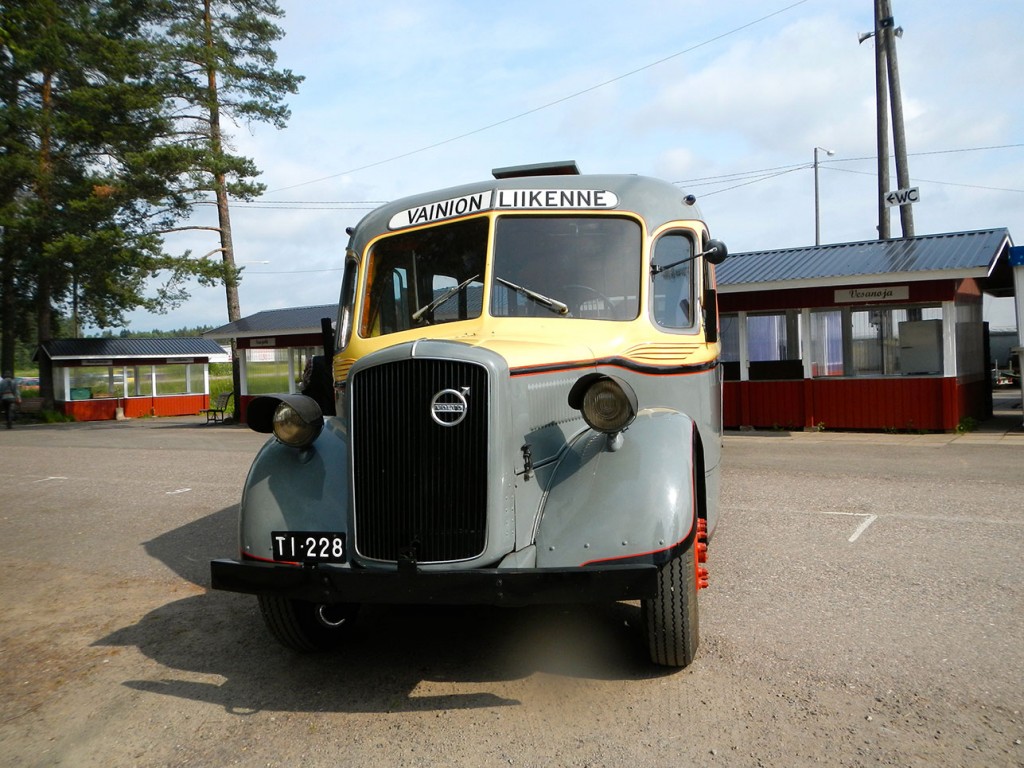

It is well known that fidelity to the historical period plays an important role in hobbyist reenactment. According to Jerome de Groot, “the hardcore reenactors will go to extreme measure to ensure that his uniform and equipment conform to the requisite standards”.14 Yet, measuring the legitimacy of objects in the Evacuee Trail follows a different logic to that found in the better part of hobbyist reenactment. Here, family heirlooms alternate with museum pieces and imitations of varying degrees of fidelity, which were purpose-made for the occasion. Authenticity is only of minor importance: “[w]hat matters most is a symbolic resonance with the foundational narratives of their personal and communal identities”.15 Props, in other words, are used as ritual objects, instrumental in social bonding among the participants.
Enacting the ethics of identity
Scenarios played out in the Evacuee Trail usually paint fragments of an ethical ideal, which resonates with the narratives of identity circulating in cultural texts. This ethical ideal forms the basis of people’s self-perception as members of their ethno-national community. When it is performed in a commemorative ritual, it is experienced as a powerful force that fosters identity grounding and communal allegiance among the participants. The ethics performed in the Evacuee Trail involve a particular version of sisu (stamina, guts), the personality trait that is not only needed in circumstances of forced displacement, but is also ostensibly a defining element of the Finnish character. Sisu involves the “ability to endure hardship” and “survive against incredible odds”.16 In Finnish literature, sisu also sometimes signifies self-sacrifice and generosity towards fellow human beings.17
Participants in the Karelian Evacuee Trail see the event as an opportunity to enact their own personal and family histories, while at the same time performing a foundational event in a broader ethnic and national discourse. In Historical Re-enactment: Narrativity, Affect and the Sublime (2015), I discuss two memory-based scenarios enacted in the Evacuee Trail events I observed in situ. The first scenario, enacting physical endurance, involves a woman who walked the several-kilometres trail in the 2012 Somero trail barefoot, carrying her baby in a sling across her chest; the second scenario, involving enactment of generosity, involves a local landowner, who participated in the 2013 trail in Kangasala by distributing water to the exhausted walkers.
The experience of suffering by the young woman mentioned above can be related to Edmund Burke’s notion of the sublime. According to Burke, pain and danger can provoke the strongest emotions a person is capable of feeling.18 Yet, what is usually a terrible experience, can also be delightful “at certain distances, and with certain modifications”.19
The narrative the young mother in Somero was enacting, however, went beyond a generic paradigm of the sublime. The remarkable power of her performance, I propose, is related to the distinctive temporality of commemorative reenactments such as the Karelian Evacuee Trail. It involves a particular double exposure, in which, on the one hand, the historic distance between the reenacted event and the reenactment ritual is minimal, so much so that some participants were able “reenact” their own personal experiences as children; and on the other, the reenacted event is seen as liminal and timeless, with participants enacting the story lines of the extra-temporal communal narrative.
The young woman and her baby are only one example of this temporal “double exposure”. By experiencing physical fatigue and discomfort, the woman could imagine what the evacuation might have felt like for her ancestors. At the same time, she was enacting the ethnic and national ideal of sisu, the resilience and courage that features in many evacuation stories. As for those participants in the same event who were originally evacuated from Karelia as children, they were able to “read” the woman’s baby, as well as other children participating in the walk, as both their own mirror image, and a representation central to their communal self-perception. Ultimately, the performative effect of this double bind is that of communal bonding, and of assurance that the significant narratives will travel across generations.
My other example, which illustrates even more patently how the Finnish national imaginary is played out in reenactment rituals, pertains to the 2013 Evacuee Trail in Kangasala. This time, the organisers of the event had full support from the local landowner Markku Meurman. As chairman of the Kangasala heritage society, Meurman was involved in the organisation of the Trail from the very beginning. He also gave permission to the local Karelian society to use his estate for the event, including a parking area for the participants, a meandering pathway from the fields and forested areas for the procession and a small chapel where a kantele concert was held.
Despite not being of Karelian origin himself, Meurman believes that maintaining Karelian traditions is relevant not only to the younger generations of the evacuee community, but also to Finland more broadly:
It started roughly one year earlier. […] We have old Karelians who are very active, but now new, active young people have also joined their activities. That is important, it is awfully important from the continuation viewpoint. […] It is difficult to get young people interested because of their work commitments. Karelians have managed to get relatively young people to join. Usually those active people have been between sixty and eighty years, but now you can have even people who are under fifty.20
Meurman also joined the reenactment event as one of the participants, offering water to the tired walkers. Symbolically, this was a re-enactment of Meurman’s own family history. In the aftermath of the war, his family estate contributed approximately sixty hectares of cultivable land for the resettlement of the evacuees. Born after the war had ended, Meurman is nevertheless fully aware of his family’s contribution:
[The evacuees] arrived in several stages. They were all from the Karelian Isthmus, from Kivennapa, those who arrived here. We received many people from Kivennapa. Some of the people from Kivennapa went to Padasjoki [a municipality adjacent to Kangasala] among other places, but we received people only from Kivennapa.
[…]
We discussed the settlement of the Karelians many times while my parents were still alive, especially the fact that at Liuksiala we welcomed the Karelians willingly and endeavoured to organise everything for them as much as we could, even though there was a shortage of everything in those days.21
As in the case of the young woman and her baby described above, Markku Meurman’s gesture of welcoming evacuee reenactors to his estate, and his performative act of helping them regain strength with the gift of water, operate simultaneously at several levels of signification: personal-familial, ethno-national, and generic-universal. The paramount ethical dimension of this symbolic act — that of communion and self-denial for the common good, and of the Finnish national unity beyond any ethno-tribal divide — endows it with a distinct cathartic and affective power.
Conclusion
A century ago, Benedetto Croce famously argued that, if historians wanted to understand the “true history of a Ligurian or Sicilian neolithic man”, or the “history of a blade of grass”, they had to try to “make [themselves] mentally” into one.22 The concept of “empathetic history” is today most readily associated with R.G. Collingwood’s classic text, The Idea of History. The events of the past do not simply reveal themselves to the historian, argued Collingwood. Rather, the historian has to “re-create them inside his [sic!] own mind, re-enacting for himself so much of the experience of the men who took part in them as he wishes to understand”.23
This idealist proposal has since been widely criticised as not grounded on verifiable truth claims. Is empathy with the experience of others ever really achievable? Peter Munz, among others, argued that it was not:
First, it would require an aptitude for intuition, which we do not even have when it comes to members of our own family, let alone when we are dealing with strangers who lived hundreds of years ago. Second, there is no way of telling whether the results of any such pretended empathy are genuine or not.24
Today’s re-enactors are perhaps in no better position to achieve ‘empathy’ than the desk-bound historians at the receiving end of Croce’s or Collingwood’s plea. Yet, they can construct the past through bodily performance, and this experience can produce affect and inspire community cohesion.
Two decades ago, the late Australian historian Greg Dening complained that historical reenactment tends to “hallucinate a past as merely the present in funny dress”; “patronise the human condition in hindsighted superiority”; and “remove the responsibility of remedying the present by distracted, unreflective search for details of a past whose remedying will make no difference”.25 The Karelian Evacuee Trail shows that reenactment practices can also be a vehicle of civic pride and engagement.
Acknowledgments
This research was supported by the European Union under the FP7-PEOPLE-2012-IIF program. The beginning stages of research were completed under the auspices of the University of Technology Sydney.
References
Burke, Edmund. 1757. A Philosophical Enquiry into the Origin of Our Ideas of the Sublime and Beautiful. London: R. and J. Dodsley.
Croce, Benedetto. 1921. Theory and History of Historiography. London and Sydney: Harrap.
de Groot, Jerome. 2008. Consuming History: Historians and Heritage in Contemporary Popular Culture. London and New York: Taylor & Francis.
Dening, Greg. 1992. Mr Bligh’s Bad Language: Passion, Power, and Theatre on the Bounty. Cambridge: Cambridge University Press.
Hart, Roderick P. 1995. Modern Rhetorical Criticism. New York: Allyn & Bacon.
Kuorsalo, Anne. 2014. Evakkovaelluksen Avaus [Opening of the Evacuation Trail] 2013 [cited February 2014]. Available from http://www.evakkovaellus.fi/Annenpuhe 14713.pdf.
Laakso, Sirkka. 1994. Elämää Edestakaisin; Karjalaisten Evakkotaival 1939-1944 [Life Back and Forth: The Karelian Evacuee Trail 1939-1944]. Lappeenranta: Etelä-Karjalan Museo.
Lewis, Richard D. 2005. Finland, Cultural Lone Wolf. London: Intercultural Press.
McCalman, Iain, and Paul A Pickering. 2010. “From Realism to the Affective Turn: An Agenda.” In Re-Enactment History: Historical Re-Enactment: From Realism to the Affective Turn, edited by Iain McCalman and Paul A Pickering, 1-17. London and New York: Palgrave Macmillan.
Mikula, Maja. 2014. “Historical Reenactment: Narrativity, Affect and the Sublime.” Rethinking History. doi: 10.1080/13642529.2014.982347.
Mikula, Maja. 2015. “Vernacular Museum: Communal Bonding and Ritual Memory Transfer among Displaced Communities.” International Journal of Heritage Studies. doi: 10.1080/13527258.2015.1020961.
Niukko, Kirsi. 2009. “The Concept of Landscape among Karelian Migrants in Finland.” Journal of borderlands studies no. 24 (2):62-77.
Runeberg, Johan Ludvig. 1878. Lyrical Songs, Idylls and Epigrams. Translated by E. Magnusson and E. H. Palmer. London: Kegan Paul.
Slotkin, Richard. 1992. Gunfighter Nation: The Myth of the Frontier in Twentieth-Century America. New York and Toronto: Atheneum.
Zerubavel, Yael. 1995. Recovered Roots: Collective Memory and the Making of Israeli National Tradition. Chicago, IL: University of Chicago Press.
Maja Mikula is Senior Lecturer in the School of Arts and Humanities at Nottingham Trent University. Her recent publications include ”Vernacular museum: communal bonding and ritual memory transfer among displaced communities” (International Journal of Heritage Studies 2015), ”Historical re-enactment: narrativity, affect and the sublime” (Rethinking History 2014), ”The island monastery of Valaam in Finnish homeland tourism: Constructing a ’thirdspace’ in the Russian borderlands” (Fennia 2013) and Key concepts in Cultural Studies (Palgrave MacMillan 2008).
- McCalman and Pickering 2010, 3. [↩]
- Niukko 2009, 66. [↩]
- Kuorsalo 2013. [↩]
- Ibid. [↩]
- Hart 1995. [↩]
- Slotkin 1992, 5 [↩]
- Zerubavel 1995, 9 [↩]
- Giddens 1990, 92. [↩]
- I.T., 29 June 2010. [↩]
- Laakso 1994, 17. [↩]
- Mikula 2014, 12–13. [↩]
- Mikula 2015, 5 [↩]
- Ibid., 12. [↩]
- de Groot 2008, 103. [↩]
- Mikula 2015, 15. [↩]
- Lewis 2005, 59. [↩]
- An example is Runeberg’s poem Peasant Paavo (Runeberg 1878, 203-205). [↩]
- Burke 1757, 13. [↩]
- Ibid., 13–14. [↩]
- Meurman, personal comm., 4 March 2014. [↩]
- Ibid. [↩]
- Croce 1921, 134–135. [↩]
- Collingwood and Dussen 1993, 97. [↩]
- Munz 1997, 846 [↩]
- Dening 1992, 4-5. [↩]